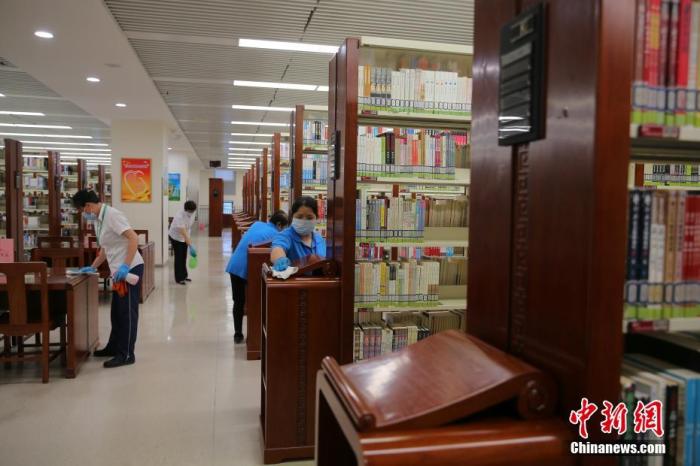China News Service, September 28. According to the news on the website of the Ministry of Culture and Tourism on the 28th, a few days ago, the Public Service Department of the Ministry of Culture and Tourism issued the "Guidelines for the Reopening of Public Libraries and Cultural Centers (Stations) on Epidemic Prevention and Control Measures (Second Edition)" ( Hereinafter referred to as the "Guide"), the "Guide" proposes that all localities should adjust the level of epidemic prevention and control risk and emergency response level, and in accordance with the requirements of the local party committee and government, strengthen the precise prevention and control of public libraries and cultural centers (stations), and adhere to the "one One strategy for museums (stations)", scientifically and dynamically adjust the time and items of reopening.
Data map: The staff of the Beijing Library carried out three-dimensional elimination of the library.
Photo by China News Agency reporter Yang Kejia
The "Guide" clarifies that if the prevention and control risk level is adjusted to a medium-high risk area, it is recommended to temporarily close the venue.
Venues where employees or cases with suspicious symptoms are found should immediately take quarantine measures, strengthen close contact tracking, disinfection of epidemic sites, etc., temporarily close the venues and resume opening after the situation is under control.
In terms of venue prevention and control, the "Guide" specifically stipulates several aspects such as disinfection and cleaning, provision of protective materials, ensuring effective ventilation, strengthening prevention and control propaganda, and making emergency response plans.
Including, if you use centralized air conditioning, check whether the equipment is normal before turning it on, and whether the new air outlet and the exhaust outlet are kept at a certain distance; operate with the maximum fresh air volume during operation, and regularly clean, disinfect or replace the air outlet and other equipment and components; venues Emergency response areas are set up within the premises, and qualified units should set up temporary isolation points or medical assistance points.
The "Guide" requires that venues and venues should gradually resume opening in sub-regions and sub-projects based on the actual situation of epidemic prevention and control.
Sites that do not meet the opening conditions and projects that are prone to gathering and close contact with people should be temporarily closed.
At the same time, it is necessary to do a good job in the public announcement of the reopening, clarify the opening hours, appointment methods, service items, admission instructions and other related content, and release to the public through various channels such as online and offline.
It is necessary to strengthen personnel entry and exit management.
Scientifically set up access to the venues, arrange special personnel for strict management, and implement systems such as appointment registration, wearing masks, measuring body temperature, showing health codes, and real-name registration.
Those who fail to cooperate or interfere with the epidemic prevention work shall promptly notify relevant departments to deal with them in accordance with laws and regulations.
At the same time, each venue can combine the needs of prevention and control work to conduct total control and dynamic control of the number of people entering the venue.
To avoid the formation of crowds.
Plan the open area in advance, and give priority to outdoor and scattered areas.
Arrange special personnel to guide and divert the people to the museum (station), guide personal protection, and ensure a safe distance between people.
The "Guide" proposes that public libraries and cultural centers (stations) at all levels will gradually restore offline services of venues under the premise of strengthening epidemic prevention and control and ensuring safety, and continue to expand the scope of book lending and the scale of cultural activities, based on the actual needs of local people. Develop offline services such as various forms and appropriate scales of reading promotion activities, mass cultural activities, cultural training and guidance, and exhibitions. Under suitable weather conditions, organize cultural activities for the masses in open spaces, reasonably control the number of people, keep a safe distance, and take protective measures.

